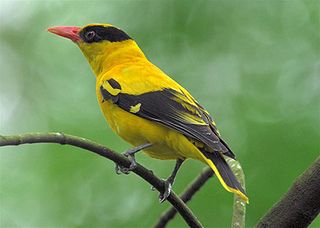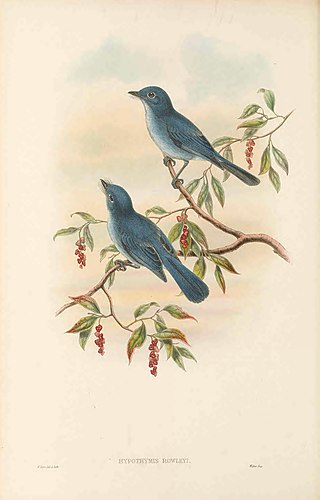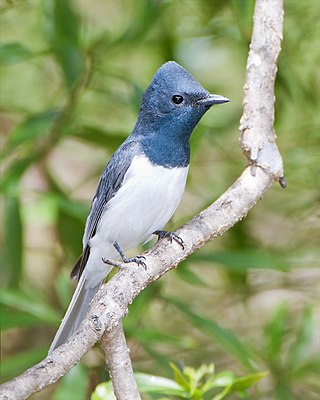
The Old World orioles (Oriolidae) are an Old World family of passerine birds.

The drongos are a family, Dicruridae, of passerine birds of the Old World tropics. The 31 species in the family are placed in a single genus, Dicrurus.

The square-tailed drongo, formerly the common square-tailed drongo, is a passerine bird in the family Dicruridae. It is a common resident breeder in parts of southern Africa.

The silktails are a group of birds endemic to Fiji. The two species are placed in the genus Lamprolia. They look superficially like a diminutive bird-of-paradise but are actually closely related to the fantails.

The cerulean flycatcher is a medium-sized, blue passerine with bright cerulean blue plumage, a bare white orbital ring, dark brown iris, bluish black bill and pale blue-grey below. The young has a shorter tail and grey underparts. It is the only member of the monotypic genus Eutrichomyias. Although it resembles a monarch flycatcher, it is actually related to the fantails.

The pied monarch is a species of bird in the monarch-flycatcher family, Monarchidae. It is endemic to coastal Queensland in Australia.

The crow-billed drongo is a species of bird in the family Dicruridae. It is native to moist tropical forests of southeastern Asia where its range extends from India to the Philippines and Indonesia. It is a completely black bird with a shallowly forked tail and is similar in appearance to the black drongo. It breeds between April and June, the cup-shaped nest being built in the fork of a branch by both birds, the female afterwards incubating the eggs. It is a common bird and the IUCN has listed it as "least concern".

Grallina is a genus of passerine bird native to Australia and New Guinea. It is a member of a group of birds termed monarch flycatchers.

The golden monarch is a species of passerine bird in the family Monarchidae found in New Guinea. Its natural habitats are subtropical or tropical moist lowland forests and subtropical or tropical moist montane forest. The golden monarch displays marked sexual dimorphism, the male a striking golden colour with black mask, wings and tail, the female a golden or golden-olive colour. Both bear a characteristic 'teardrop' white pattern below the eye.

The azure-crested flycatcher or the blue-crested flycatcher, is a species of bird in the monarch flycatcher family Monarchidae. It is endemic to Fiji, where it is found on Taveuni.

The leaden flycatcher is a species of passerine bird in the family Monarchidae. Around 15 cm (6 in) in length, the male is lustrous azure with white underparts, while the female possesses leaden head, mantle and back and rufous throat and breast. It is found in eastern and northern Australia, Indonesia, and Papua New Guinea. Its natural habitat is subtropical or tropical mangrove forests in the northern parts of its range, in the south and inland it is eucalypt woodland.

The brown fantail is a species of bird in the family Rhipiduridae. It is found in Bougainville Island and Guadalcanal.

The white-bellied thicket fantail is a species of bird in the family Rhipiduridae. This species is one of 47 in the genus Rhipidura. It is found in New Guinea. Its natural habitats are subtropical or tropical moist lowland forests and subtropical or tropical mangrove forests.

The Samoan fantail is a species of bird in the family Rhipiduridae. It is endemic to Samoa and is found in Upolu and Savaiʻi islands.

The Kadavu fantail is a species of bird in the fantail family Rhipiduridae. It is endemic to Kadavu and Ono in the Kadavu archipelago, in southern Fiji. It is closely related to the streaked fantail of the rest of Fiji, and forms a superspecies with the numerous island species of fantail ranging from the Solomon Islands to Samoa.

The streaked fantail is a species of bird in the family Rhipiduridae. Rhipidura verreauxi has precedence over Rhipidura spilodera. It is found in Fiji, New Caledonia, and Vanuatu. Its natural habitats are subtropical or tropical moist lowland forests and subtropical or tropical moist montane forests.

The Sulawesi fantail is a species of bird in the family Rhipiduridae. It is endemic to Sulawesi in Indonesia. Its natural habitats are subtropical or tropical moist lowland forests and subtropical or tropical moist montane forests

The sooty thicket fantail is a species of bird in the family Rhipiduridae. It is found in New Guinea.

The Papuan scrubwren is a species of bird in the family Acanthizidae. It is found in the highlands of New Guinea ; its natural habitat is subtropical or tropical moist montane forests.

The frill-necked monarch is a species of songbird in the family Monarchidae. It is endemic to the rainforests of the northern Cape York Peninsula in Australia.





















